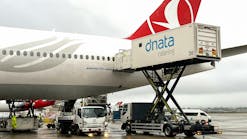Aircraft Service International Group's corporate parent BBA Aviation plc rolled out its Zero Injury Philosophy + Process campaign in 2009 to all its global aviation units to create, as the name suggests, a safety culture that would communicate the company's commitment to health and safety for all its workers.
"Safety compliance and performance in aviation has always been an expectation and a real focus," explains D. Bradley Keith, ASIG's director of Health, Safety, Environmental and Training. "That's a mandate driven by regulations and our customers' expectations. But under ZIPP, safety became more of an orchestrated company-wide common goal with clear programs and goals to ensure the safety and security of all employees."
Each of ASIG's facilities, for example, now uses the same measurement metrics and global reporting system to record all accidents and incidents to track performance. The reporting system enables continuous monitoring and analysis of practices in real time. In his capacity, Keith gets accident and incident reports literally an hour after the episode was initially documented.
Keith also walked us through an array of what he termed "safety-enabling systems." ASIG, for example, launched its first module of computer-based training covering its fueling program in 2008 and has since used the CBT model to provide training needed in both job-specific skills, such as pushback operations, along with standard company-wide modules covering health and safety policy compliance.
"CBT reduces classroom training," Keith adds, "and we can put that time to better use through on-the-job training. That's where people really learn the best – by doing."
Keith, by the way, comes to the ASIG safety job with an interesting take on the subject. A geologist by education, he held various positions within regulatory agencies associated with health and safety matters before joining the aviation industry.
"I think that experience makes me a good safety ambassador since I know that many safety regulations are implemented for good reasons," he adds.
SAFE
However, there is one element of the ZIPP campaign that ASIG with its approximately 70 ground handling, fueling and airport service sites in 70 cities throughout North America, Central America, Europe and Asia can claim as one of its own valuable additions. In fact, the ASIG program won a BBA Aviation Leadership Award for Health and Safety last year.
During 2010 ASIG piloted a supplementary program at several of its location. The program's original purpose was two-fold:
- Assist the company to identify a method that would allow it to analyze deviations from standard ramp procedures.
- Provide immediate feedback to ramp employees.
Basically, a ramp manager was to spend a part of the day observing ramp workers going about their crucial chores. What was going right? What was going wrong? Afterward, the managers could offer on-the-spot feedback for a job well done or a job that could use improvement.
Using lessons learned from the initial testing, ASIG later merged the strengths of both programs to create a single, user-friendly tool called SAFE – Safety Audit Feedback Engine. After further testing to prove its effectiveness, the SAFE program became a part of all ASIG's operations in 2011.
Currently, SAFE combines a set of standardized business specific audit forms with the on-the-spot coaching and feedback element of ASIG's original observation program. Feedback is an essential part of the program – so much so that ASIG developed videos to help managers first observe and then provide the right kind of feedback.
Keith shared a few of these videos with us. In addition, we also received a copy of an "Into-Plane Fueling Safety Audit" form complete with 38 items managers would make note of as they watched a refueler in action on the ramp.
During the 2-minute-42-second clip, we counted 25 individual movements the refueler made. From our perspective, the refueler looked as if he'd covered all his bases correctly. Or did he?
- Under the "General" category, for example, did the refueler properly show his airport ID outside his clothes?
- Under the "Ergo" category, did the refueler use both hands to carry the hose?
- Under the "PPE category, did the refueler put on his chemical-resistant gloves?
- Under the "Arrival" category, is the position of the refueler's vehicle appropriate for the aircraft?
- Under the "A/C Servicing" category, did the refueler inspect the fuel receptacle lugs prior to connecting his equipment?
- Under the "Wrap-up" category, did the refueler observe the proper order for disconnecting his equipment?
- Finally, under the "Depart" category, did the refueler complete a post walk-around?
As it turned out the refueler did do a good job, but still missed a few items. Afterward, we watched two videos labeled "Positive Feedback" and "Negative Feedback."
In the positive video, the ramp manager starts out by first noting what the refueler did right. Protective vest. Check. Ear protection. Check. Safety glasses. Check.
"I appreciate that," the manager says, "However, I did notice a few things we should work on."
For one, the refueler failed to chock his cart. And he wasn't wearing safety gloves; he'd left them on the cart. Finally, while he had an ID hanging around his neck, it was not visible. The manager wraps it up by asking if the refueler had any questions. Both walk away looking pleased.
On the other hand, 3 seconds into the negative feedback video, the ramp manager says: "What's the matter with you, man. You didn't have your gloves on. You didn't have your cart chocked. And where's your ID at? You know better than that? I don't want to talk to you again about this." At which both turn away clearly disgusted with each other. In all, it took 15 seconds to ruin a hard-working, well-meaning ramp worker's day.
"The way we set up this exercise is to have the observer use the checklist when watching the first video and mark down the safe and at-risk behaviors," Keith adds. "Then we make sure we all witnessed the same things before we show the positive vs. negative feedback videos. It's the same message with a different delivery – it makes quite an impression!"
SAFE data are all carefully analyzed and thanks to the company's extensive computer database capabilities, station managers can very easily and very quickly see what's going right and address what's going wrong. More importantly, under ZIPP, managers are strongly encouraged to ask for help right from the get-go.
"We're not the safety police," Keith says of his department. "I think of what we do as offering consulting services in safety. I work for the managers. It's totally different when our employees in the field identify a problem and come to us asking for help."
ELIMINATING THE 'GOTCHA'
Keith says one of the main lessons learned from the videos is "to eliminate the 'gotcha.' " The SAFE's direct observation and mentoring aspects should "focus less on discipline and more on direct mentoring and performance-improvement plans," he says. "That's the softer approach."
That softer approach of SAFE may be doing its part in the overall ZIPP campaign. Each of BBA Aviation's facilities uses the Recordable Incident Rate as its primary health and safety performance metric. RIR measures the number of full-time employees out of every 100 who sustain a recordable injury or illness.
A couple of years ago, BBA Aviation also added "near misses" to its list of RIR reporting requirements. The near misses enabled ramp managers to focus on what "might" have happened and take a proactive approach to further improving safety.
According to BBA Aviation's most recent Corporate and Social Responsibility Report, the group-wide RIR at the end of 2010 was 3.25, a reduction of 22 percent from 2009 – and the lowest rate since the corporate parent started monitoring progress under ZIPP.
What's more, 124 out of 211 reporting locations achieved an RIR of zero in 2010, including a particularly large ASIG operation at McCarren International Airport in Las Vegas.
"The fact that half of our locations can get the RIR down to zero is proof that it can happen," Keith says.
What might those "zero" locations be doing differently?
"In our business, it's all about boots on the ground," Keith explains. Management teams at these zero-RIR sties maintain a visible presence on the ramp.
"That's really critical," he adds. And even when not on the ramp, Keith says managers lead by example, hold regular meetings, have open door policies for communications and fairly administrate discipline when problems do occur.
And the most critical difference might be the easiest of them all.
"What these guys do that's different is that they pat ramp workers on the backs, shake their hands and tell them face to face that they're doing great jobs," Keith adds. "Employees hunger for that."




